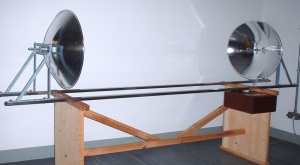Burning mirrors
| Burning mirrors | |
|---|---|

| |
| On display at | Il Giardino di Archimede - Un Museo per la Matematica |
| Type | Hands-on |
| Creator | Il Giardino di Archimede |
| Topics | geometry, conic sections, mirrors, history |
| License | (Copyrighted, Patented, Open source, Creative Commons, etc) |
| [Il Giardino di Archimede Website] | |
| [[1] Video Tutorial] | |
This exhibit is part of the exhibition Beyond the compasses at Il Giardino di Archimede (Florence, Italy).
Description
The exhibit consists of a pair of parabolic mirrors, making a set of indoor "burning mirrors". Solar rays are substituted with those from a halogen lamp. The lamp is located in the focus of a first parabolic mirror, from which the light rays are reflected and come out parallel to the axis. A second reflection on the second mirror concentrate the light rays again on the focus of this second mirror.
Turning on the lamp, the heat generated by the bulb put in the focus of one mirror, manages to light a match in the focus of the other.
Activities
The exhibit shows properties of foci.
Background
A tradition dating back to Plutarch says that Archimedes invented the mirrors with which set fire to the Roman ships besieging the city of Syracuse. How they built these mirrors Plutarch does not say.
The simplest form of a burning mirror is that of a paraboloid of rotation, a surface that is generated by rotating a parabola around to its axis. In a parabola there exists a point F, called focus, with the properties that rays parallel to the axis concentrate in the focus.
This property of the parabola can be used to build a mirror that concentrates solar rays (which we may consider parallel because of the great distance of the Sun) in the focus, where they can light up inflammable materials.
History and museology
The exhibit is part of a path on the conical sections. It is particularly connected with an exhibit on the paraboloid of rotation obtained from the rotation of a parabola and with an exhibit on the sound parabolas. Other exbihits concerns the focal properties of the ellipse and the ellipsoid.